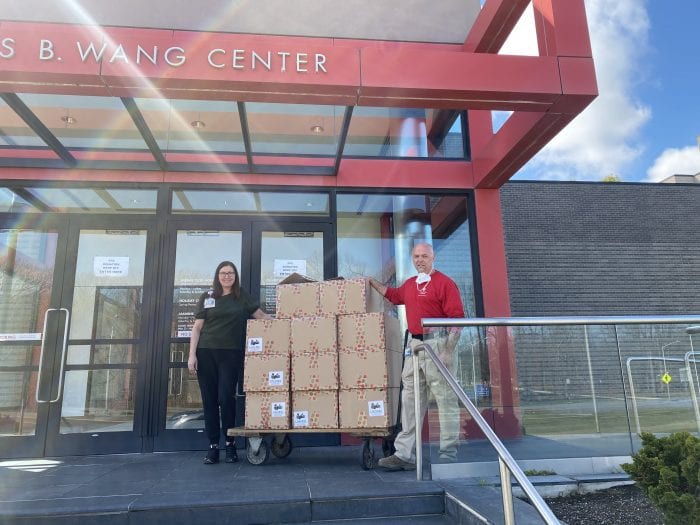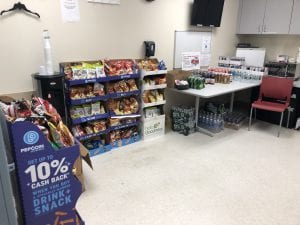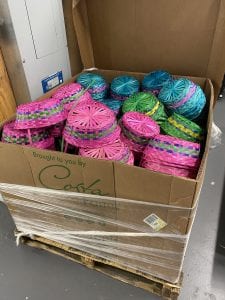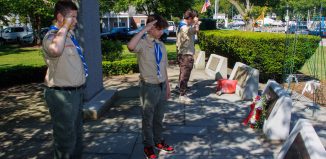Donations Help SB Health Care Workers During Worst of Pandemic

While Stony Brook University Hospital staff were taking care of the sickest residents in the midst of the pandemic in Suffolk County, residents did what they could to return the favor.

In addition to cheering for health care workers, first responders and essential employees each night at 7 p.m., numerous residents and businesses made donations of everything from lifesaving N95 masks to food to comfort care.
After 10 weeks of accepting donations from March through early June, Stony Brook had collected nearly one million pieces of personal protective equipment, including masks, gloves and head and food coverings, 33,500 comfort care items such as snacks, hand lotion, puzzles and coloring books, 18,000 meal donations, 575 video messages of support and 435 iPads for telemedicine.
These donations bolstered the spirits of the staff and provided vital comfort during everything from the process of conducting COVID-19 tests in the South P Lot to the recharging breaks doctors, nurses and hospital staff took after caring for patients.
“The comfort piece was a bit more striking for the patients and the staff,” said Roseanna Ryan, director of Patient Advocacy & Language Assistance Services at SBU Hospital. “The need for the staff to have a respite area to recharge during this extremely challenging time was something that we might not have initially anticipated. The donations we were able to use went such a long way.”
Indeed, even some of the smaller items helped the masked men and women health care heroes throughout the hospital system.
During testing, some of the medical professionals worked 12-hour shifts, administering test after test for reeling residents. Items such as breath mints, ChapStick and even eye coverings that would help health care workers take a nap in their car before returning for the next shift proved incredibly helpful, said Colby Rowe, Trauma Center Education & Prehospital outreach coordinator. Rowe worked with the emergency management team at the university, primarily coordinating the donation center.
“I received lots of text messages from people on the receiving end saying, ‘Thank you so much.’ They felt appreciated by the community, Rowe said.
Rowe added that the hospital performed ably in ensuring that the staff had sufficient PPE equipment to help them with their dangerous but important work.
The university took a wide range of assistance. Some donations, like snack food, found a home in the break room. Others, however, wound up helping people in different locations.
Stony Brook received more than 400 Easter baskets. Rowe was on the phone with a civilian friend from the U.S. Department of Defense, who told him that Fort Hamilton in Brooklyn had to postpone an Easter event.
Rowe loaded up his truck and drove the Easter baskets to Brooklyn. That’s not where the community spirit stopped. On the way, several baskets blew out of his truck on Route 347.

“I had about four cars pull over to help me” retrieve the boxes, Rowe said. “That’s a sign of the times.”
None of the boxes, which were donated to the children of soldiers, sustained any damage.
Rowe also said the university worked to make sure support staff, including housekeeping and the people moving the carts to usher patients around the hospital, benefited from these gifts.
The most consistent donated items were the three-dimensional printed face shields and hand sanitizer, which faculty who stayed to help frontline workers made on campus. In total, the university received more than 14,000 face shields and 509 gallons of hand sanitizer.
Ryan and Rowe said the hospital was grateful and humbled by each donation they received.
Several groups offered consistent gifts. The Three Village Coronavirus Forum Facebook group, which Three Village resident Michael Ehrlich led, raised hundreds each week through membership donations. They shopped at Target and Walmart to buy comfort care items.
Frito-Lay donated a couple of truckloads of chips to stock the respite room, while the Three Village Dads Foundation raised money to feed frontline workers.
The donations helped fill in some gaps during the year as well. National Nurses Week and National EMS week both occurred in May. While the hospital typically honors these professionals with gifts to show their appreciation, the response to COVID-19 was the priority during those times. The donations, however, provided material for care packages.
The pandemic triggered needs the hospital never had before, Ryan said.
“We had to identify different ways to allow our patients to communicate with their loved ones, while there was no visitation or limited visitation,” Ryan said. The hospital redeployed nursing staff into family liaison roles to provide friends and family with updates.

For the patients, the hospital put together comfort bags, which included activities like word searches, crossword puzzles, stress balls, aroma therapy, eye masks, and dry erase boards to allow patients who were able to write to communicate with nurses outside a door, which helped preserve PPE.
At this point, the university has some supplies left over, which it will likely use during the current, planned reopening of the university side of Stony Brook.
In addition to receiving donations from the community, Stony Brook also benefited from donations from people in other countries, including China, Korea and Germany.
“People sent really moving and emotional notes,” Rowe said. “We saw a lot of good in people” during a difficult time.
Ryan was also grateful for all the support from the university.
“The planning and preparation from senior leadership put us in a position where we were able to be successful in getting to the other side of this,” Ryan said. “Leadership at the state level also helped tremendously with that.”






